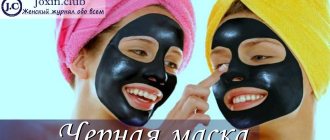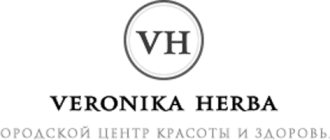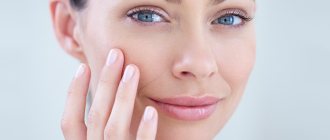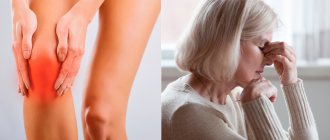A face mask made from PVA glue and pharmaceutical activated carbon has long gained wide popularity. It allows you to remove blackheads or comedones, which are constant companions of people of both teenage and older age. In most cases, those with oily skin suffer from them. Sometimes no other means give the desired result. A mask made of glue and charcoal, on the contrary, turned out to be very effective. What's the secret?
Comedones, or blackheads, appear on the face due to excess sebum secretion
Why do comedones appear?
Comedones, or blackheads, appear for many reasons. The most important of them is disruption of the sebaceous glands. A number of factors can trigger their development:
- Hereditary predisposition. If mom or dad has encountered a similar problem, the chance of the child having it reaches 97%.
- Hormonal imbalances. In most cases, adolescents and women during menopause and before menstruation suffer from comedones.
- Use of certain medications. We are talking about long-term therapy here. Due to the aggressive action of medications, hormonal imbalance occurs. The result is the formation of dots.
- Insufficient or improper care. This could be unsuitable makeup or skin care products.
- Unbalanced diet. A lack of fruits and vegetables not only leads to the appearance of comedones, but also disrupts the functioning of the entire body.
- Frequent stressful situations, pathologies of the nervous system, depression.
Plus, such defects appear in those who live in areas with unfavorable environmental conditions.
Treatment methods
Unhealthy skin is not just a problem for teenagers. Urban ecology, unhealthy diet, inappropriate cosmetics – there can be many reasons. All of them lead to the formation of comedones (blackheads).
Cosmetologists recommend three treatment options for blocked sebaceous glands:
- In the most advanced cases - antibiotics.
- Chemical peeling is a cosmetic procedure with synthetic acids.
- Mechanical peeling – scrubs.
Each of the proposed paths has side effects. Antibiotics do not have the best effect on our digestion and stomach condition. Chemical peeling is not always safe and can cause irritation and allergic reactions. And scrubs injure the upper layers of the epidermis.
The effectiveness of glue and coal - myth or reality?
Until recently, it was possible to completely clean pores only in beauty salons, resorting to one of the expensive procedures. But now, thanks to the advent of a face mask made from activated carbon and PVA glue, you can even do this at home.
Thanks to the properties of PVA, pores are freed from dirt and oil.
According to reviews from those who have already tried the product, the effect of the procedure is similar to cleansing the skin in a salon and chemical peeling. There are no side effects such as redness or burning sensation, and the result is visible immediately. This mask helps remove not only comedones, but also inflammation, acne and overly enlarged pores.
The glue contains polyvinyl acetate. This is an absolutely safe substance that can penetrate deeply into even the smallest pores. After applying the glue to the skin, the water evaporates, and the PVA becomes viscous and sticks to it.
Activated carbon, sold in pharmacies, can:
- Absorb accumulated toxins and impurities.
- Remove spots, inflammations and other defects.
- Narrow pores.
- Normalize the activity of the sebaceous glands.
- Make skin smoother and silkier.
A homemade mask should be applied with a brush so as not to stain your fingers black
Does PVA glue help with blackheads?
If you believe the reviews, then yes, and not bad. What causes this effect? PVA glue is an emulsion of polyvinyl acetate in water, equipped with a plasticizer and additives. It has a characteristic smell, and most often it is used not in cosmetology, but in construction, production, printing, etc. (depending on the specific type of PVA).
How does glue help deal with clogged pores? Firstly, it has excellent adhesive ability. Secondly, when applied, the glue is able to fill small gaps, several millimeters in size, when hardened, it becomes glassy and has a slight shrinkage. However, it is not fragile, so it is removed from the skin as a film and does not get stuck in the pores.
Those who use PVA for facial procedures give the following argument to skeptical girls: it is diluted with water, and is also non-toxic, therefore harmless.
Preparing to apply the mask
Application of the product does not require preparation. The only condition is that it is recommended to apply it only to steamed skin:
- Pour hot water into a wide container. If necessary, add medicinal herbs or a few drops of any essential oil.
- Bend over the container and cover your head with a towel. Stay in this position for several minutes.
- For complete cleansing, wipe the skin with a cotton swab dipped in tonic.
After steaming, you can use a mask of glue and activated charcoal.
A mask of activated carbon and glue can be applied to the entire face or locally to problem areas
Types of masks and degrees of protection
There is no consensus on the benefits of wearing masks during a pandemic. But with the growing number of cases, doctors and ordinary people increasingly consider this necessary. Let’s understand the types of masks so that we don’t have any illusions and make the right choice.
Regular medical masks
The protective properties of a simple 3-layer mask from a pharmacy are low; according to the Nizhny Novgorod Research Institute of Hygiene and Occupational Pathology, it allows up to 34.0% of the aerosol to pass through tests due to a loose fit. The fabric quickly becomes wet from breathing and becomes a source of infection itself. The wearing period should not exceed 2-3 hours.
In gauze dressings with a cotton filler of 40 g, the “breakthrough” in tests reached 58.0%.
But there is a point in wearing them. They are designed to protect others from infection released from the respiratory tract of an infected person when they cough, sneeze and talk. He may have no symptoms and may not know that he is dangerous to others.
Respirators
This class can already be called personal protective equipment (PPE). Respirators do a much better job of protecting a healthy person from infected people. They are distinguished by their design:
- tight elastic bands around the head;
- nose plate;
- tight fit.
Everything to prevent infectious agents from slipping past the filter layer. If the respirator has a non-return valve, this will help wick away moisture, keep it dry longer and be worn for up to 4-8 hours.
You need to choose a respirator taking into account the protection class.
Respirators are divided into 3 protection classes. This can be determined by the FFP (Filtering Face Piece) marking:
- FFP1 protects against infection better than a medical mask, but not enough. Recommended for use in contact with objects that may be infected. Of the 3 classes, it allows the most aerosol particles to pass through.
- FFP2 – may protect against coronavirus, but does not guarantee it. Getting it in conditions of shortage is a joy for medical workers.
- FFP3 – has a filtering efficiency of at least 99.0% according to the European standard EN149. It is recommended to use it in areas of infection, in contact with COVID-infected people. Such a respirator will only be effective when combined with a screen, or better yet, a protective suit, followed by disinfection/disposal. Such strong protection of only the respiratory organs without other parts of the body will not be effective.
However, you need to take into account that the higher the class, the more powerful the filtering ability, which means it is more difficult to breathe.
Can sports masks be used to protect against coronavirus?
On the Internet you can find various DIY products. Masks are made from sports helmets and diving masks. The filter element is made from improvised materials, usually cotton wool and gauze. Unfortunately, this is not enough. Special materials made from fine-fiber fabrics are needed to effectively trap viruses. Such an accessory can only protect against the virus when sneezing, coughing and talking.
If you attach a real filter element from a respirator or gas mask to such a mask, it will perform its function. It is important to properly remove, dispose of, or treat the filter to avoid infection from it.
Exotic protection can be a full-face mask with an oxygen mixture for deep-sea diving, with clean air from cylinders.
How to carry out the procedure
To make a mask, the product must be applied to the face in a thick layer. Leave until completely dry. This usually takes about 10 minutes. After the specified period of time, the resulting film must be removed. The comedones will go away along with it. The last step is washing with cold water, which will close the pores. At the end, the skin should be lubricated with a rich cream.
If glue gets on your clothes while making a mask, don’t worry - it can be removed using simple methods.
Benefits of a black face mask
Removing open comedones is not the only benefit this product brings. It also has the following actions156:
- accelerates metabolic processes;
- saturates cells with useful minerals;
- removes toxins;
- tightens pores;
- soothes irritations;
- normalizes complexion;
- mattifies the skin;
- relieves swelling;
- refreshes and tones the skin.
They should not be used too often.
Similar Recipes
The recipe for the black mask may change, but its effectiveness remains the same. Only the ingredients will be different. In any case, the product will help in the fight against ugly spots.
Replacing glue
Glue is often replaced with chicken egg white. You can prepare the product according to this recipe:
- separate the white from the yolk;
- crush a couple of tablets of activated carbon into powder;
- combine the ingredients and mix thoroughly.
Apply the resulting mixture to the skin of the face and leave until completely dry. Remove and wash with warm water. PVA can also be replaced with gelatin. This substance is often used to make masks. It needs to be filled with water and after swelling, put in the microwave. After complete dissolution and cooling, mix with crushed activated carbon.
The harm of a homemade black face mask
Here are 3 main reasons why you should avoid using a homemade black face mask156:
- Not suitable for everyone. If you have sensitive or dry skin, this product will not suit you. It dries and tightens the skin, in your case this can develop into pain.
- Skin tightening. The composition should not be kept for more than 10 minutes, as it has a drying and tightening effect. This may damage the skin. Homemade black masks with charcoal, gelatin and milk especially often have this effect.
- Unpredictability of the result. At home, it is impossible to maintain the correct balance of ingredients and the exact concentration of active ingredients.
It is not at all necessary to make a black face mask with your own hands; you can buy a ready-made cosmetic product.
Contraindications and possible harm
A mask for blackheads on the face with PVA glue is contraindicated for those who suffer from an allergy to one of its components. It is quite easy to detect such a reaction. It is enough to apply the prepared composition to the elbow and leave for a quarter of an hour. If after rinsing the skin turns red or a burning sensation appears, you should not use the product. Another contraindication is dry and dehydrated skin. According to experts, this mask can speed up the process of wrinkle formation. In this situation, it is better to use other home recipes.
PVA glue and regular activated carbon are good helpers in the fight against comedones on the face. A mask prepared on their basis effectively cleanses and tightens pores. If one of the components is not available, it can be replaced with improvised means.
PVA as a means of combating skin imperfections
Is PVA glue harmful to leather? Reasoning logically, we can come to the conclusion that if children are allowed to use this glue to make paper crafts from a very early age, then most likely PVA does not pose any threat, with the exception of cases of contact with mucous membranes.
Face mask
Polyvinyl acetate (abbreviated PVA) is an emulsion dissolved in water, odorless and colorless, absolutely non-toxic and non-hazardous. It is also used in the production of acrylic and water-based paints.
Having great adhesive power, when applied, PVA fills all the pores on the face and gradually dries, drawing out impurities from them. The adhesive mask can be removed very easily - in one piece. The effect of such a mask is superior to expensive hardware procedures performed in beauty salons. Unlike chemical peeling, it does not cause irritation or redness on the skin.
Despite the harmlessness and absence of obvious contraindications to the use of PVA glue as a means of combating blackheads, an allergy test must be performed before the first use. To do this, apply a small amount of the substance to the bend of the elbow and observe the skin reaction for 10-20 minutes. If the skin is not red, there is no burning or itching, you don’t have to worry.
Classification and stages of development of comedones
Comedones can be closed or open.
Closed comedones are white subcutaneous nodules about 1 mm in diameter. Due to the small opening in the skin, the contents of such nodules have almost no contact with the external environment, and the keratinocytes that form at the mouth of the duct cannot “break through” to the surface of the skin and increase the pressure inside.
Sometimes closed comedones appear in newborns in the first weeks of life. At this age, the disease goes away on its own and no treatment is required. In other cases, closed nodules develop into open comedones [3].
Open comedones are blackheads measuring 0.5-1.0 mm. The reason for their dark color is the melanin pigment and oxygen oxidation of the comedonal contents through a large hole in the skin [1]. Once the trigger factor is eliminated, they usually stop growing and disappear.











